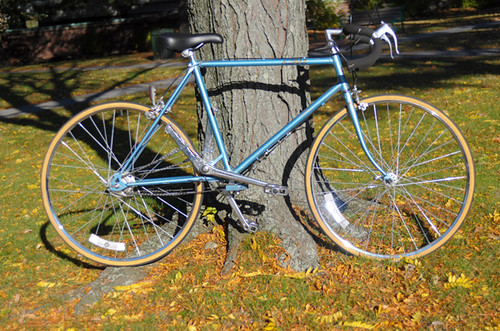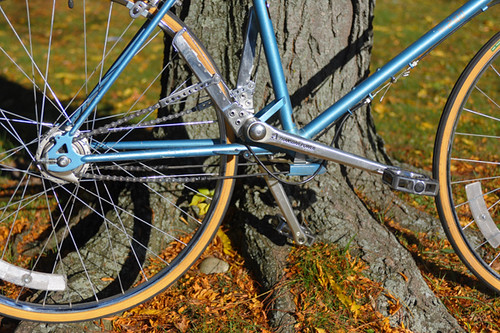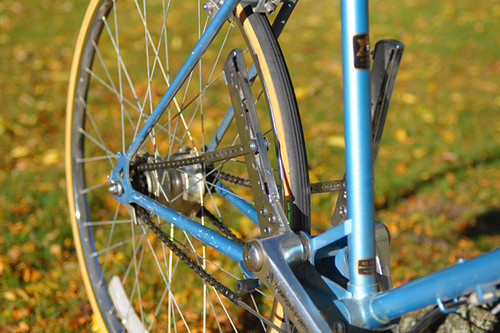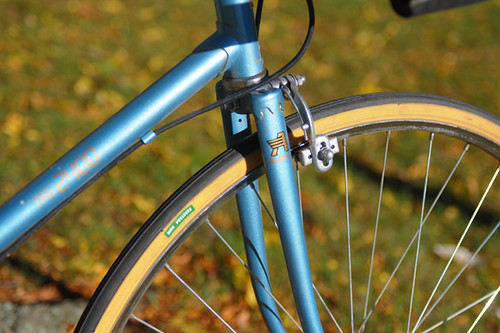Alenax: the Ultimate Vintage Freak Bike?
Looking for the perfect bike for that End of the World themed ride? I think I found it. Having seen so many crazy two-wheeled contraptions in the basements and garages of collectors over the years, I sometimes think that I've seen it all and that no bike can really surprise me anymore. And that's usually when I'll stumble upon something like this. Notice anything out of the ordinary?
Meet the Alenax TRB 2400, the original Transbar Power bicycle. It was designed to be pedaled using up-and-down motions instead of circular motions. Presumably this was done to approximate the feel of walking, thereby making cycling feel more "natural." Here is a video of this in action.
In leu of a crankset, the Alenax sports two pivoted "transbars." I won't pretend to understand how exactly the system works, but see this article by Jobst Brandt and the Alenax blog for additional descriptions.
A stem-mounted shifter controls the gears
- on Alenax's own internally geared hub.
But aside from the pedaling system, the Alenax looks disconcertingly normal. Lugs, skinny tubes, shimmery paint, tan wall tires. It's basically just a typical '80s roadbike, retrofitted to accommodate the Transbar Power system. It is also a good 5lb heavier that a standard roadbike from that era.
When Alenax came out with these bikes in 1983, they marketed aggressively, intending to revolutionise bicycle design. They attended all the bike shows, made promotional videos, courted distributors. But amazingly, the concept failed to catch on. By 1993 they threw in the towel, and all that's left today are the (apparently highly collectible) traces of their efforts. At some point more recently, it looks like there was an attempt to modernise and rebrand, but that too does not seem to have worked out.
I am doing some freelance work for Harris Cyclery, and one of the perks is getting to see things like this. Jon Harris dragged the Alenax out of the shop's basement one day, then proceeded to ride it jauntily up and down the block. "It feels a little strange until you get it up to speed," he explained, "but after that it's fine!" The bike is too big for me to ride, so I cannot confirm that. But they do have a partially assembled step-through version in the basement...











Nice bike! I like it because its innovator was a risk taker, but in obvious hindsight it's clear that it didn't revolutionize the bike industry.
ReplyDeleteI wasn't sure if you also felt the same way, but in your article you wrote the following.
"But amazingly, the concept failed to catch on." Were you being sarcastic or sincere...I couldn't tell. I chuckled thinking you were being sarcastic. But if you were being sincere, I have to ask why you were so shocked that it didn't catch on.
Anyway, as I read this article and thought about bike revolution, I wondered if you heard about the $9 cardboard bicycle.
http://www.fastcodesign.com/1670753/this-9-cardboard-bike-can-support-riders-up-to-485lbs
In my humble opinion, that right there is bicycle revolution. I should be amazed and shocked if this doesn't catch on.
Thanks and loving your blog as always.
I bought my Alenax at a distress merchandise store for about $35. I fell in love with the novel shifting method. It is a very normal feeling bike and with a leg problem I have, it isn't necessary to stroke the peddle to the upper or lower limit to propel it just fine. The low range is totally adequate for the local hills and high is a good cruise . I like it.
DeleteI too bought mine at a similar outlet, paying about twice as much. But, the REAL reason it didn't "catch on" was due to patent disputes. The orignal Australian designer sued an interloper company and got them removed from the marketplace, hence their incredibly reduced prices. Today Cardio surgeons claim they are ideal for low-stress rehab hence their renewed popularity and regained original pricing which was in the $300-range! Whenever I rode mine [now long since in storage but still in excellent condition] heads would invariable turn and I would be stopped every hundred yards or so by puzzled onlookers. I may just get it out, dust it off and do it all over again!
DeleteWhen I was a little boy my father retrofitted the crank set of an adult-sized tricycle so that a woman with one leg could use it around town. He basically put a spring on the right crank arm so that it would return to the original position after she pushed down on it.
ReplyDeleteToo weird for me!
ReplyDeleteIf you've come this far you just have to go after the Facet BioCam, Scott Dickson, and 3 PBP victories. The stuff of legend.
ReplyDeleteAccelerating in a 168 inch gear takes a while but the system does work.
I still have most of the bits for a Bio-Cam, it came off the bike Lynn Brooks used to win the 1982(I think)Nice triathlon. I put it on a nice Raleigh Carlton racebike and rode it a bit. It seemed like there was some effect but nothing like the adds promised. When I built a fixed wheel for it and tried it on rollers it had this pronounced surge as the sprocket advanced and retreated on the cam. Pretty unsettling but entertainingly freaky.
DeleteSpindizzy
Last time I saw Scott Dickson he was riding conventional cranks.
DeleteTwo third places an three wins at PBP is not so shabby, for rider or for equipment.
Whenever I think I know a lot about pedalling and how the human animal does it, I remind myself of this weird stuff that works too.
Reminds me of St. Louis-style pizza -- a perfectly fine pizza pie, but instead of perfect, triangular slices, it is cut into squares. Take something perfect and mess it up with unnecessary tinkering -- just because you can doesn't mean you should.
ReplyDeleteI forgot all about these things! I never saw one up close but I would occasionally see one out and about when I worked at a triathlon shop in Baltimore in the 80s. It was always going the other direction or just a little too far away. By the time I got to where I thought it should be there was only the chattering of the birds and an empty sidewalk(and sometimes a strong, but not unpleasant smell, like a wet Aardvark).
ReplyDeleteLike the equally reclusive ElliptiGo, these 2 wheeled Duckbilled Platypussi exist, if not exactly thrive in the unexploited niches of the modern cycling environment. They are difficult to locate but the dedicated spotter can sometimes get lucky by watching bicycle racks outside the engineering departments of large universities(particularly in the northeastern U.S.).
I always get a little thrill when I see something like this out in the world, whether it's cruising along at a brisk trot like the ElliptiGo that I sometimes see around here or that Alenax I used to see scurrying from shadow to shadow way back when. I wonder if it MIGHT be a bit like the uneasy jolt our Homo Sapiens ancestors might have experienced when cresting a hill and observing a lone Cro Magnon trackstanding under a tree.
Freaky bikes, I dig em' and still have an empty hook or two in my basement...
Spindizzy
Disturbingly, I see more and more ElliptiGos on the local bike trail. The riders seem to have a difficult time steering them.
DeleteOK, I shouldn't throw ANY stones here(I know, the guy who hammered cut-off forklegs onto his bike to make a chopper, the guy who wrapped diesel soaked rags around the back tire of his Stingray to do Dragster style fire burnouts, the builder of how many tallbikes and an aggressively lethal swingbike and, and...) But ElliptiGos? Wow. The bike for people who don't wanna ride a bike, for people who don't LIKE bikes, the bike for people who will only ride a bike if it will INSULT everything good and bike-like.
DeleteI know I said I dig freaky bikes, and really(really), I do, but with the ElliptiGo I've discovered the point at which I'm willing to join the angry mob, jumping up and down and shouting outside the appliance store where they sell them (They don't sell them in Bike Shops do they? That would be like Fox News plugging Al Franken's next book, Like Julia Child serving you a deepfried Milkyway. Like, like, I dunno, somebody like, really cool doing something, like, really bad).
Yesterday when I got up and peeked out the window to see if the Mayan Apocalypse was really upon us, I was kinda expecting it to arrive on a fleet of flaming ElliptiGo's. Hordes of recently divorced men in Yoga pants, ponytails blowing free, riding the wrong way down the bike lanes humming "Call me maybe" as they cast sheets of scalding Latte' through the open windows of gridlocked minivans. Holy Crap! What if!?
I saw one that had clearly been on it's side. Can you imagine what wrecking one would be like? The moment when one realizes "This babies goin' down!" Do you ride it out in hopes of pointing it towards some empty field and sacrificing oneself for the good of mankind or punching out and letting it scythe though some used comic-book store full of the leaders of tomorrow. The term Train Wreck applies here in a way that proves it's relation to actual trains is only a metaphor.
I could go on...
Spindizzy
Thank you for news of the ElliptiGo. For soemone with knee problems that looks like a superb machine.
DeleteI agree, all messing around aside, anything that gets us outside and working up a sweat IS a good thing.
DeleteBut dang it, you can't expect us to sit here and not try to validate ourselves by denigrating anything that strays that far from our beloved dork talismans? That would be a bit too rational.
Good day.
Spindizzy
Some interesting engineering gone mad.
ReplyDeleteAmazing what the human mind comes up with to try and improve and advance. Not everything works, but it's fantastic that people try.
ReplyDeleteThanks for sharing this.
Not sure if I agree. So-called solutions to perceived rather than actual problems, which there are many, are a waste of resources.
DeleteWho defines what is a perceived or actual problem?
DeleteAnd who defines what's a waste of resources and what's not? Lots of innovation starts out as trial and error. Without trying, you don't get anywhere. Do you know how many resources venture capitalists throw at startups in hopes that the ideas that come out of them actually amount to something profitable? And how seldom that actually happens? The point is that every once in a while the risk pays off, and the payoff ends up advancing society.
DeleteUsing reciprocating treadles is an idea that dates back to the 1879 Facile.
ReplyDeletehttp://www.flickr.com/photos/jennypoo/5534177521/
It reminds me of the Jockey Cycle that my dad brought home from an auction one time in the 60s. We had lots of fun riding it around the yard. Unfortunately somebody parked it behind my dad's truck and he flattened it.
ReplyDeletehttp://www.youtube.com/watch?v=isslIh7cwoo
The Alenax wasn't the first try at this. I've seen an Italian bike from the 30's with the same mech.
ReplyDeleteOf course, there is the bike bungee.
http://www.youtube.com/watch?v=bLeBHI3LYAo
I saw a couple at the Copake Bicycle Auction (worth a post if you can get there this spring) two years ago. They did not bring all that much, if I remember correctly.
ReplyDeleteI confess to not really looking directly at them. Hideous, blasphemous, and dorky all at the same time. (And not the good hideous/blasphemous/dorky.)
I found the MTB model of one of these in great condition several years ago at the city dump. I didn't like riding it and kept it around just for the novelty of it. Eventually sold it to regain the storage space.
ReplyDeleteI'm sure you'd appreciate the bicycle I've seen on the trail here in Seattle lately. It looks to be built somewhat along these lines, only the rider stands up as if they were cross country skiing... and the action of the pedaling is about the same as cross country skiing.
ReplyDeleteThe wheels seem about like a regular bike but the handlebars sort of stick straight up and the position of the rider is standing upright. The first time I saw it I was shocked... with the oddest appearance of the rider rushing down the trail while standing up vertically and looking very, very tall.
I know there's all kinds of weird bikes built in odd configurations, like those horizontal bikes and the eggshell racing bikes. But in more than a decade of trail riding I hadn't seen a vertical skiing bike like that before.
Sounds like another ElliptiGo sighting. Someone should start tracking them to try to determine their population and range...
DeleteSpindizzy
"Sounds like another ElliptiGo sighting. Someone should start tracking them to try to determine their population and range..."
DeleteIf I design the ear tags, will you fabricate them?
I volunteer to man the tranquilizer gun.
DeleteAnother odd thing about this contraption was that there wasn't any seat. I also was amazed at how fast it went. I was being run by a young woman and it really made quite an impression to see her flying by standing about 7 feet tall!
DeleteI saw her twice within a day or so... but haven't seen her since.
Which one of us looks most like Marlon Perkins?
DeleteThere isn't a strong rationale for linear pedaling on a regular bicycle, but it would probably make sense for velomobiles, possibly also for recumbents--the mechanical advantages would be superior.
ReplyDeleteAh the Treadle Bike...Here's some nerdery for you nerds: This pedaling system actually predates conventional chain drives on safety bikes (for real, mid 1880s). With even earlier examples being found on high wheelers and other bicycle like machines. Before chains, this was a safe way to keep your feet from getting sucked into the wheel and maimed. I've ridden one of these and it's weird, but actually works quite well- if you like Stair Masters.
ReplyDeleteDecades ago, Harold Knochin of International Bike (Commonwealth Ave. and a story himself)told me the Koreans hired an unnamed American bike biz guy to market these. Big advertising budget, of which he got a percentage. And although he knew the concept was going nowhere, what was the point of telling the Koreans?
ReplyDelete